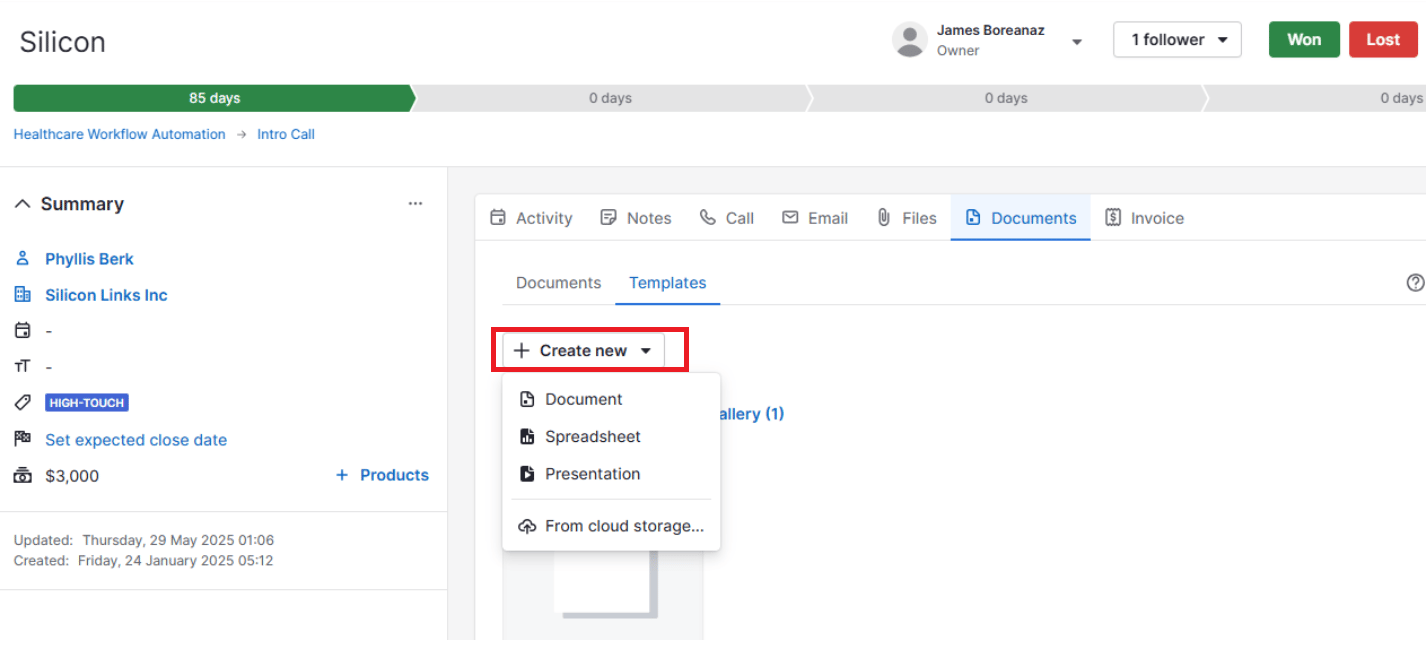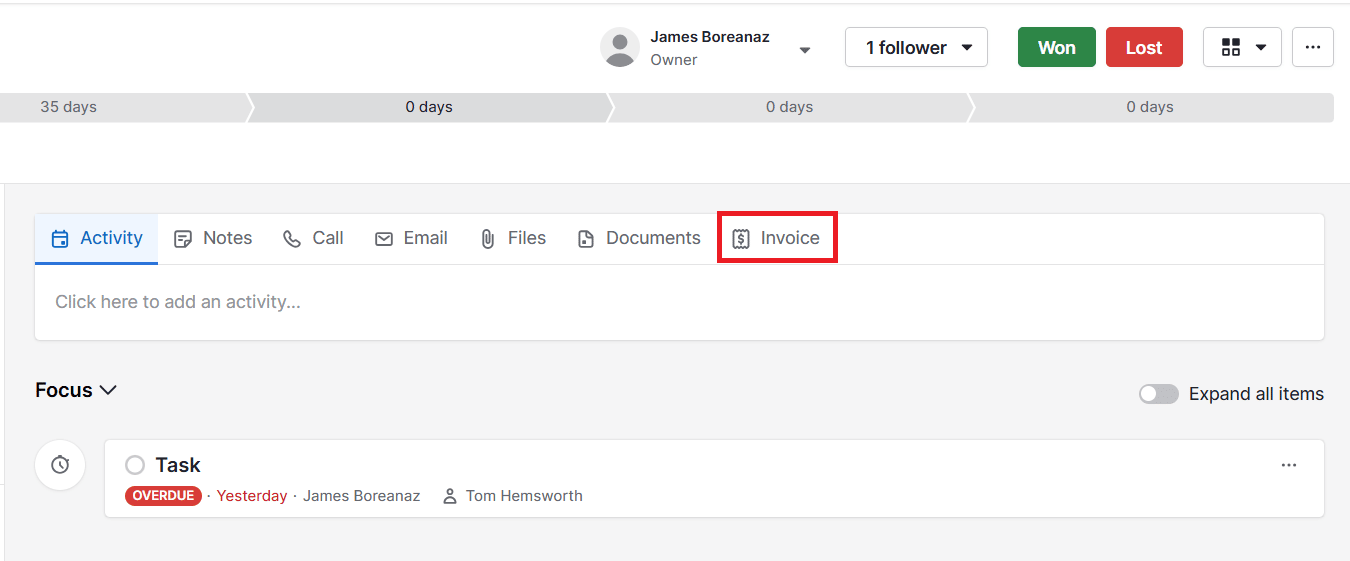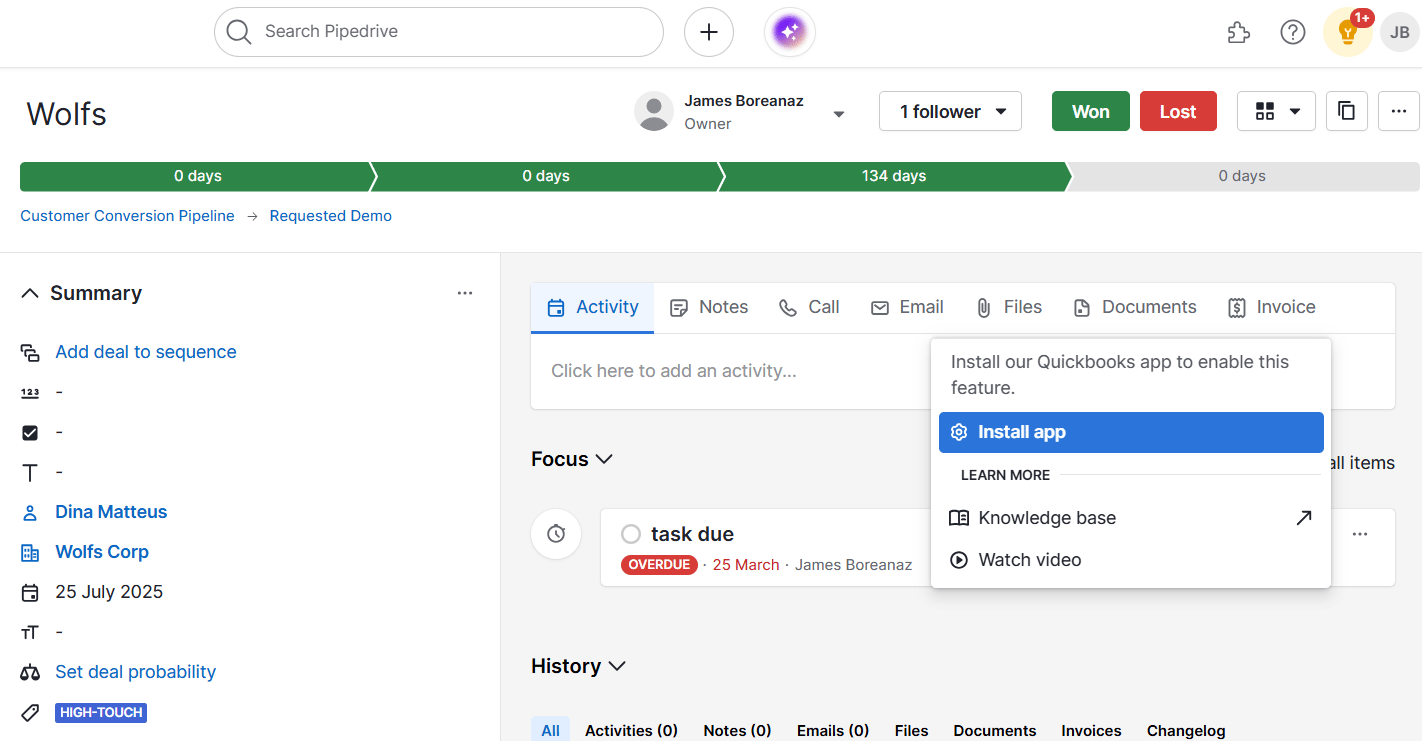Clear, well-structured sales agreements build stronger client relationships and help small and medium-sized businesses accelerate deal closures.
A watertight contract is essential for SMBs, where every sale counts. Clearly defined scopes and payment terms create more room for trust, support smoother collaboration and ensure timely transactions across every customer account.
In this article, you’ll learn how to write an effective sales agreement tailored to your small business. Explore what key elements to include and the different types of sales contracts, then use the customizable template to create your own.
What is a sales agreement?
Relying on verbal promises or vague documentation can lead to customer complaints, lost revenue and broken client trust. A sales agreement solves this problem by defining what each party expects. It protects both sides legally and provides a fallback if things go wrong.
This document typically outlines the terms and conditions of a sale between a buyer and a seller. Without it, you’re operating on guesswork.
Free sales agreement template for SMBs
Download Pipedrive’s customizable sales agreement template to create professional, reliable agreements easily.
The contract template includes key details like scope, payment terms and timelines. It covers all the necessary information for a smooth and transparent sales process.
Create professional sales contracts easily with Pipedrive's sales agreement template
Why SMBs need solid sales agreements
With limited time and resources, SMBs can’t afford to leave sales agreements to chance. Clearly defined terms reduce miscommunication, delayed payments, legal disputes and lost revenue.
Take a closer look at some of the benefits of having a sales agreement in place.
Set clear expectations
Verbal agreements or vague email confirmations often lead to mismatched expectations. If a client says, “I thought that was included” and there’s no written scope, it’s hard to prove otherwise.
A sales agreement details exactly what you’re selling and when deliverables are due.
Clarity keeps everyone on the same page, meaning clients know what to expect and SMBs can spend time and resources on relevant tasks.
Setting expectations also builds trust. When clients see that your business is transparent and professional, they’re more likely to stick around, refer others and pay on time.
Keep your cash flow healthy
If a client delays payment or doesn’t settle, they derail your ability to manage payroll, do business with suppliers or fund other projects. A solid sales agreement states payment terms in black and white, ensuring clients pay invoices on time and keeping your cash flowing.
For example, the agreement spells out deposit requirements, milestone payments (partial payment on completion of a project stage), due dates and late penalties. As a result, clients can see upcoming payments and know when to issue the money.
Protect your business
Every business relationship starts with good intentions, but things don’t always go smoothly. A sales agreement acts as a safeguard when projects stall, clients go silent or expectations change.
If a client suddenly requests work outside the original scope, the agreement clarifies what it includes and whether you need a new quote to cover additional activity.
This process sets clear boundaries, ensuring your business doesn’t waste time and resources on extra, unpaid work.
Business sales agreements also clarify your liability. If something goes wrong with the product or service, the agreement defines what you’re responsible for.
For business owners of small companies without in-house legal teams, these built-in protections are a crucial layer of defense against costly legal disputes and damage to brand reputation.
What should a sales agreement include?
A strong sales agreement covers all the key details that protect your business and keep projects running smoothly. These details provide clarity for customers, prevent delays and keep your deals moving forward smoothly.
Here’s a breakdown of the essential components:
Parties involved | Full legal names and addresses of both the buyer and the seller. SMB tip: Avoid confusion by using consistent business names across documents and systems. |
Description of goods or services | An overview of the service or product you sell, including quantity, service scope and other specifications. SMB tip: Be specific with your description. “Web development” is vague, but “five-page WordPress site with mobile optimization” is clear. |
Pricing and payment terms | The total cost that your customers owe. Terms include deposits, payment schedules, accepted payment methods and late payment penalties. SMB tip: Outline milestone payments for longer projects to improve cash flow. |
Delivery terms or timeline | A breakdown of when and how you’ll deliver your product or service, including lead times, shipping terms (if applicable) and service start/end dates. SMB tip: Add internal buffers for delivery delays and clarify who monitors overdue tasks. |
Warranties and guarantees | An outline of what you guarantee (in terms of quality, functionality and performance) and for how long. SMB tip: Keep warranties realistic. For example, offering a lifetime guarantee may not be sustainable. |
Termination and cancellation clauses | Explain when and how either party can end the agreement. Specify written notice periods, refund rules and obligations upon termination. SMB tip: Add protection for partial work completed if a client cancels mid-project. |
Confidentiality and intellectual property (optional but important) | Clarify who owns intellectual property (like content, data or designs) once the deal is complete. Include a basic confidentiality clause to protect sensitive sales data and business information. SMB tip: If you work with contractors or creatives, include clear ownership clauses that define who retains rights to the work, especially for logos, designs, copy or software. |
Dispute resolution and legal jurisdiction | Define how your business handles disputes. For example, you might start with a mediation before proceeding to court (if necessary). SMB tip: Choose your local jurisdiction to handle legal matters to avoid extra costs. |
Sales agreements contain many moving parts, and staying on top of every edit and update can quickly overwhelm busy sales teams. A clear system helps minimize errors, keep information current and move deals forward without delays.
Pipedrive’s Smart Docs feature streamlines the entire process. Your team can create, send and track professional sales documents (like proposals and contracts) within the CRM.
Here’s an overview of how Smart Docs works:
The Smart Docs add-on ensures everyone works from the most up-to-date version for easy collaboration. It even lets customers sign documents electronically with eSignatures. That means fewer errors, faster turnaround times and a smoother path from proposal to closed deal.
How to write a sales agreement: 5 tips for SMBs
A well-crafted sales agreement is clear, comprehensive and legally sound, preventing scope creep and future legal headaches.
Here are five practical tips to help you draft sales agreements that protect your business, set the right expectations and build stronger client relationships.
Disclaimer: Pipedrive isn’t a legal services provider, and this content doesn’t constitute legal advice. Consider consulting a qualified professional to help you create a legally binding contract.
1. Ensure total clarity
Total clarity in a sales agreement means you and your client understand what you’re selling, what the product or service includes or excludes and when delivery will happen.
There’s no room for guesswork or assumptions, making it easier to keep projects on track and protect your working relationship.
Here’s how to build that clarity into every sales agreement:
Use precise language. Avoid vague terms and spell out what your product or services include. Instead of “Provide website support as needed”, say, “Provide up to 10 hours of website maintenance per month, including plugin updates and security checks”.
List exclusions explicitly. Define what you’re not responsible for to manage expectations and protect your time. For a web development project, you might say, “This agreement doesn’t include e-commerce functionality, ongoing SEO services or third-party content creation”.
Break down deliverables and deadlines. Use clear milestones, deadlines and delivery stages to reduce misunderstandings and keep everyone accountable. Instead of “Launch in July”, specify “Final delivery by July 25 after draft approval by July 10”.
Clear agreements also prevent scope creep, making it easier to enforce sales agreement terms and conditions if a dispute arises.
Note: Scope creep happens when a project grows beyond its original goals (often through extra tasks, last-minute changes or added requests) without an explicit agreement or additional payment. It can strain budgets, timelines and team capacity.
Imagine you’re halfway through delivering a website build and the client suddenly asks for an integration you didn’t discuss.
With a sales agreement, you can point to the agreed terms, explain the need for a change order and keep the project (and your margins) on track.
2. Use a customizable template
A customizable sales agreement template saves time, ensures consistency and helps you avoid errors from writing each contract from scratch.
For example, instead of rewriting your payment terms every time, you can start with a standard clause like “50% deposit due upfront, with the remaining 50% payable upon project completion”.
This process speeds up your workflow, reduces the chance of leaving out critical terms and gives every client a clear, professional agreement that aligns with your business standards.
Start with a strong base agreement that includes all the key sections (like scope, payment terms and timelines), then adjust the details for each client or project. This approach keeps your contracts professional and consistent while allowing flexibility for different deals.
Here’s how to make the most of your template:
Use clear formatting. Structure your template with clear section headings, bullet points and consistent language so it’s easy to navigate and edit. This simple formatting helps you work faster and makes your agreement easier for clients to digest.
Get your master template reviewed once. Hiring a lawyer for every contract isn’t realistic for most SMBs. Investing in a legal review of your master template can catch red flags and prevent costly mistakes down the line.
Create a version control system. Track edits to your template across different projects or clients. Monitoring these variations ensures you use the most up-to-date version and gives you a reliable paper trail if questions ever arise.
To manage your templates effectively, use tools like Pipedrive to store and organize your sales agreement templates directly in your client relationship management (CRM) system. That way, your entire sales team can quickly access contracts to speed up the process.
Here’s how Pipedrive’s CRM stores templates:

The CRM also allows sales reps to record all sent and signed documents in a central place. They can keep tabs on which leads in the sales pipeline are ready to sign a sales agreement and which need more nurturing before closing the deal.
Download your free sales invoice templates here
3. Write the agreement to fit your business
Your sales agreement should reflect how your business operates. When your contract mirrors your day-to-day operations, it’s easier to uphold, simpler for clients to understand and less likely to lead to disputes.
Imagine a small creative agency using a 15-page legal contract for a short-term branding project. The agreement includes clauses on data warehousing, arbitration across jurisdictions and complex indemnity language.
Clients feel overwhelmed, the sales funnel slows down and trust erodes before the work begins.
Here are some of the ways to ensure your agreement aligns with your business:
Match your delivery process. Describe your products or services to reflect how you deliver them. For example, if you offer ongoing support rather than one-time fixes, include terms that cover response times and scope for that support.
Use language your clients understand. Avoid overly technical or legalistic terms that could confuse clients. Use clear, simple language that sets realistic expectations and fosters transparency.
Include essential legal terms. Some clauses are must-haves to protect both parties, such as the terms of the sale, cancellation policies, liability limits and confidentiality agreements. Including these shows you take the business relationship seriously.
Remember: While it’s essential to tailor your sales agreement to your business, having a law firm review it ensures a legally binding document. This step can save you from costly disputes or loopholes later on.
4. Link customer payments to key milestones
Linking payments to milestones means aligning your income with tangible progress. The process gives you better cash flow control and reduces the risk of late or missed payments.
Instead of waiting until the end of a project to get paid in full, you receive smaller payments as you hit agreed-upon checkpoints.
For example, a B2B IT services provider might structure payments as:
25% due upon contract signing
35% due after system setup and initial testing
The remaining 40% due after final deployment and client approval
This milestone-based approach helps cover business costs along the way (like payroll and suppliers) and ensures the client stays engaged throughout the project. When client engagement is high, you get quicker feedback, faster sign-off and a smoother path to delivery.
Here are some tips for tying customer payments to key milestones:
Define clear, achievable milestones. Break the project into phases and link each to a payment. Each milestone should represent real progress that both you and the client can verify. For example, in a product management project, phases might include design approval, first draft or prototype delivery.
Be specific about payment timing. Use clear timelines like “50% due within five business days of signed approval on draft two”. This clarity removes confusion and helps keep the project on track.
Include penalties or late fees if needed. If late payments have caused issues in the past, include late fee terms to encourage customers to settle sales invoices on time. Even a small deterrent can keep things moving smoothly.
Centralizing payment information and client activity makes it easier to monitor milestones and payments. With everything in one place, you stay ahead of delays, follow up faster and maintain a healthy cash flow.
Stay organized by using Pipedrive’s CRM to track deals, attach key documents like signed agreements and monitor progress toward each milestone.
Here’s an example of how an invoice attachment appears in Pipedrive:

Pipedrive’s invoicing feature also allows you to create, send and track invoices directly from the CRM. Invoice statuses update automatically under your deals, so you can instantly see upcoming or overdue payments.
To use the invoicing feature in Pipedrive, download the QuickBooks app directly from any deal:

You can also add custom fields to view payment statuses and keep tabs on billed, due and overdue amounts.
Here’s an overview of how to add custom fields in Pipedrive:
With a complete view of every client’s status, you can manage timelines and invoicing without switching tools or losing visibility.
5. Plan for challenges and hurdles
Building clear procedures for delays, scope changes or breakdowns in sales communication helps you create a smoother path forward when things don’t go to plan. This preparation protects your time, preserves client relationships and reduces stress when unexpected issues arise.
Say that a new client goes quiet during a key review phase. Your agreement states that you pause project work after 10 business days of no response, with delivery dates and payment schedules adjusted accordingly.
With this contingency plan in your sales agreement, you’re not stuck waiting indefinitely or rushing to make up for lost time – both of which put pressure on your time and resources.
Here’s how to prepare for common challenges in your sales agreement:
Define what happens if timelines shift. Include a clause that outlines how to handle deadline extensions, whether that’s an agreed-upon notice period, revised delivery dates or additional fees if delays are client-driven.
Create a simple change request process. Outline how clients can request additional work, what information they need to provide and how you’ll price and schedule changes. This clarity prevents informal requests from derailing your scope.
Add buffer time around deadlines. Account for potential delays by building in realistic time frames for customer feedback, sign-off and delivery – keeping expectations in check and reducing pressure on your team.
Documenting these risks in your agreement reduces strain on your time and resources if challenges occur.
3 types of sales agreements (plus samples)
Different business models need specific types of sales contracts. Choosing the right agreement helps you set clear expectations, protect your interests and close deals smoothly.
Here’s a breakdown of three common types, along with sales agreement contract PDF examples to show how each one works.
1. Product sales agreement | Use when selling physical goods. The contract covers the product description, quantity, price, delivery terms and warranties. It’s ideal for SMBs selling inventory, retail items or manufactured goods. Product sales agreement example: Georgia Tech Applied Research Corporation |
2. Service sales agreement | This agreement is for selling services (like consulting, design, marketing or IT support) to customers. The contract outlines your work, when it’s due and how much you’ll get paid. It’s best for consultants, freelancers, agencies or any business providing expertise or labor. Service sales agreement sample: Career Step, LLC |
3. Subscription or recurring sales agreement | Send a recurring revenue contract for ongoing services or products, like software subscriptions, maintenance or memberships. The agreement covers recurring billing terms, renewal policies, cancellation rights and service levels. It suits businesses with repeat customers or ongoing offerings, such as SaaS companies. Subscription or recurring sales agreement example: DealHub |
Whether you’re selling products, services or subscriptions, choosing the right type of contract sets the foundation for successful relationships and faster sales.
Final thoughts
A well-crafted sales agreement sets clear expectations, protects your business, improves cash flow and builds client trust.
Get started with Pipedrive’s customizable sales agreement template to craft contracts that reflect your operations and ensure smooth deal execution.
Then, streamline the whole process using a CRM like Pipedrive. Store templates, track approvals and link sales documents to deals in one location, so sales reps can stay on top of timelines and keep deals moving forward.
Sign up for a free 14-day trial to speed up deal cycles from draft to close.






